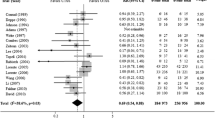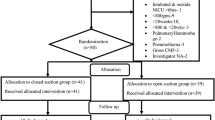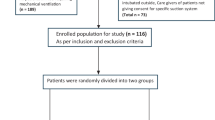Abstract
Objective
Ventilation-associated pneumonia (VAP) is a serious complication of patients in intensive care units (ICU) who require mechanical ventilation. The choice of suctioning system (open vs. closed) remains unresolved in evidence-based guidelines. This meta-analysis was carried out to analyze the effect of the type of suctioning system on the incidence of VAP.
Design
A search of the literature was used to identify randomized controlled trials addressing this question. A meta-analysis was then performed to calculate the relative risk of ventilation-associated pneumonia acquisition with the two suctioning systems.
Results
Nine trials were included, with 648 patients in the open suctioning group and 644 in the closed suctioning group. VAP occurred in 128 (20%) of the open suctioning group and in 120 (19%) in the closed suctioning group (relative risk 0.95).
Conclusions
At a given pneumonia prevalence of 20% in ICU patients there was no significant advantage for the use of either suctioning system in this meta-analysis. The choice of suctioning system should therefore be based on handling, cost, and individual patient's disease until more data are available.

Similar content being viewed by others
References
Centers for Disease Control and Prevention (2004) National Nosocomial Infections Surveillance (NNIS) System Report, data summary from January 1992 through June 2004, issued October 2004. Am J Infect Control 32:470–485
Tejada AA, Bello DS, Chacon VE, Munoz MJ, Villuendas Uson MC, Figueras P, Suarez FJ, Hernandez A (2001) Risk factors for nosocomial pneumonia in critically ill trauma patients. Crit Care Med 29:304–309
Safdar N, Dezfulian C, Collard HR, Saint S (2005) Clinical and economic consequences of ventilator-associated pneumonia: a systematic review. Crit Care Med 33:2184–2193
Tablan OC, Anderson LJ, Besser R, Bridges C, Hajjeh R (2004) Guidelines for preventing health-care-associated pneumonia, 2003: recommendations of CDC and the Healthcare Infection Control Practices Advisory Committee. MMWR Recomm Rep 53:1–36
Cook D, De Jonghe B, Brochard L, Brun-Buisson C (1998) Influence of airway management on ventilator-associated pneumonia: evidence from randomized trials. JAMA 279:781–787
Dodek P, Keenan S, Cook D, Heyland D, Jacka M, Hand L, Muscedere J, Foster D, Mehta N, Hall R, Brun-Buisson C (2004) Evidence-based clinical practice guideline for the prevention of ventilator-associated pneumonia. Ann Intern Med 141:305–313
Hess DR, Kallstrom TJ, Mottram CD, Myers TR, Sorenson HM, Vines DL (2003) Care of the ventilator circuit and its relation to ventilator-associated pneumonia. Respir Care 48:869–879
Branson RD (2005) The ventilator circuit and ventilator-associated pneumonia. Respir Care 50:774–785
Zeitoun SS, de Barros AL, Diccini S, Juliano Y (2001) Incidence of ventilator-associated pneumonia in patients using open-suction systems and closed-suction systems: a prospective study—preliminary data. Rev Lat Am Enfermagem 9:46–52
Lee CK, Ng KS, Tan SG, Ang R (2001) Effect of different endotracheal suctioning systems on cardiorespiratory parameters of ventilated patients. Ann Acad Med Singapore 30:239–244
Cordero L, Sananes M, Ayers LW (2000) Comparison of a closed (Trach Care MAC) with an open endotracheal suction system in small premature infants. J Perinatol 20:151–156
Deppe SA, Kelly JW, Thoi LL, Chudy JH, Longfield RN, Ducey JP, Truwit CL, Antopol MR (1990) Incidence of colonization, nosocomial pneumonia, and mortality in critically ill patients using a Trach Care closed-suction system versus an open-suction system: prospective, randomized study. Crit Care Med 18:1389–1393
Johnson KL, Kearney PA, Johnson SB, Niblett JB, MacMillan NL, McClain RE (1994) Closed versus open endotracheal suctioning: costs and physiologic consequences. Crit Care Med 22:658–666
Adams DH, Hughes M, Elliott TS (1997) Microbial colonization of closed-system suction catheters used in liver transplant patients. Intensive Crit Care Nurs 13:72–76
Combes P, Fauvage B, Oleyer C (2000) Nosocomial pneumonia in mechanically ventilated patients, a prospective randomised evaluation of the Stericath closed suctioning system. Intensive Care Med 26:878–882
Zeitoun SS, de Barros AL, Diccini S (2003) A prospective, randomized study of ventilator-associated pneumonia in patients using a closed vs. open suction system. J Clin Nurs 12:484–489
Rabitsch W, Kostler WJ, Fiebiger W, Dielacher C, Losert H, Sherif C, Staudinger T, Seper E, Koller W, Daxbock F, Schuster E, Knobl P, Burgmann H, Frass M (2004) Closed suctioning system reduces cross-contamination between bronchial system and gastric juices. Anesth Analg 99:886–892
Topeli A, Harmanci A, Cetinkaya Y, Akdeniz S, Unal S (2004) Comparison of the effect of closed versus open endotracheal suction systems on the development of ventilator-associated pneumonia. J Hosp Infect 58:14–19
Lorente L, Lecuona M, Martin MM, Garcia C, Mora ML, Sierra A (2005) Ventilator-associated pneumonia using a closed versus an open tracheal suction system. Crit Care Med 33:115–119
Lorente L, Lecuona M, Jimenez A, Mora ML, Sierra A (2006) Tracheal suction by closed system without daily change versus open system. Intensive Care Med 32:538–544
Subirana M, Sola I, Garcia JM, Laffaire E, Benito S (2003) Closed tracheal suction systems versus open tracheal systems for mechanically ventilated adult patients. The Cochrane Database of Systematic Reviews: protocols 2003 3
Cereda M, Villa F, Colombo E, Greco G, Nacoti M, Pesenti A (2001) Closed system endotracheal suctioning maintains lung volume during volume-controlled mechanical ventilation. Intensive Care Med 27:648–654
Maggiore SM, Lellouche F, Pigeot J, Taille S, Deye N, Durrmeyer X, Richard JC, Mancebo J, Lemaire F, Brochard L (2003) Prevention of endotracheal suctioning-induced alveolar derecruitment in acute lung injury. Am J Respir Crit Care Med 167:1215–1224
Cobley M, Atkins M, Jones PL (1991) Environmental contamination during tracheal suction. A comparison of disposable conventional catheters with a multiple-use closed system device. Anaesthesia 46:957–961
Freytag CC, Thies FL, Konig W, Welte T (2003) Prolonged application of closed in-line suction catheters increases microbial colonization of the lower respiratory tract and bacterial growth on catheter surface. Infection 31:31–37
Ritz R, Scott LR, Coyle MB, Pierson DJ (1986) Contamination of a multiple-use suction catheter in a closed-circuit system compared to contamination of a disposable, single-use suction catheter. Respir Care 31:1086–1091
Kollef MH, Prentice D, Shapiro SD, Fraser VJ, Silver P, Trovillion E, Weilitz P, Von Harz B, St John R (1997) Mechanical ventilation with or without daily changes of in-line suction catheters. Am J Respir Crit Care Med 156:466–472
DePew CL, Moseley MJ, Clark EG, Morales CC (1994) Open vs closed-system endotracheal suctioning: a cost comparison. Crit Care Nurs 14:94–100
Maggiore SM (2006) Endotracheal suctioning, ventilator-associated pneumonia, and costs: open or closed issue? Intensive Care Med 32:485–487
Author information
Authors and Affiliations
Corresponding author
Rights and permissions
About this article
Cite this article
Vonberg, RP., Eckmanns, T., Welte, T. et al. Impact of the suctioning system (open vs. closed) on the incidence of ventilation-associated pneumonia: meta-analysis of randomized controlled trials. Intensive Care Med 32, 1329–1335 (2006). https://doi.org/10.1007/s00134-006-0241-3
Received:
Accepted:
Published:
Issue Date:
DOI: https://doi.org/10.1007/s00134-006-0241-3




